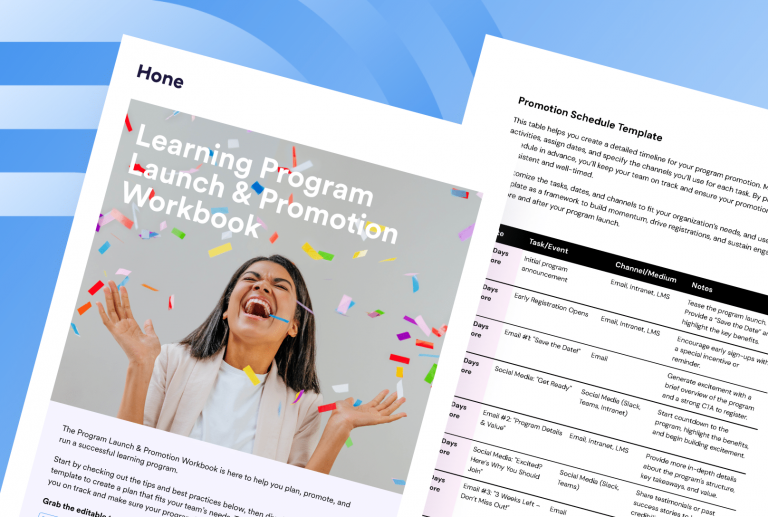What is Internal Mobility?
The definition of internal mobility refers to the movement of employees within a company from one job or position to another without leaving the organization. This can include promotions, transfers, and other career development opportunities that allow employees to gain new skills and experiences, take on new challenges, and advance their careers within the same company. Internal mobility aims to maximize employee potential and retain talented employees within the organization. Businesses created this framework to enable greater talent agility. In addition, it dissolves departmental silos and promotes a sharing mindset.
Why is an Internal Mobility Program Important?
An internal mobility program is essential for workplace retention for several reasons:
- Employee development and engagement: Internal mobility programs provide employees with opportunities to learn new skills, take on new challenges, and advance their careers, which can lead to increased engagement and motivation.
- Career advancement: Internal mobility programs can help employees advance their careers within the company, increasing their sense of fulfillment and satisfaction.
- Talent retention: By providing employees with career development and advancement opportunities, internal mobility programs can help reduce turnover and retain talented employees within the company.
- Diversification of skills: Internal mobility programs can help employees broaden their skill sets and experience, benefiting both the employees and the company.
- Succession planning: By promoting internal mobility, companies can identify and groom future leaders and ensure they are prepared for critical positions when they become available.
Internal mobility encourages employees to take on new growth opportunities that align with their long-term career goals. In addition, it gives talent the ability to pursue a broader range of prospects. Therefore, employees are more engaged and capable, and companies are more resilient.
Upward mobility is a powerful way to keep employee satisfaction and engagement high. Promoting employees sends a positive signal to their colleagues that their efforts will be rewarded. It demonstrates the organization’s values and boosts morale and productivity.
Types of Internal Mobility at a Company
1. Vertical and Upward Mobility
Upward mobility means a worker advances to a higher position. Promotions based on seniority typically come with more responsibilities and a higher salary. Vertical mobility usually means upward promotions, which can also relate to demotions.
A demotion is when an employee’s status or title decreases in the organization’s hierarchy. Workplace demotions can occur when employees produce low-quality work or do not follow policies. Demotions may also be the result of unexpected budget cuts or company restructuring.
2. Lateral or Role-to-Role Mobility
Lateral mobility means an employee moves positions with little to no change in seniority or compensation. These job changes can still be beneficial even though employees are not climbing the career ladder.
Also referred to as role-to-role mobility, it allows workers to apply the skills acquired in their current role to other business areas. Therefore, they fuel knowledge-sharing and effective cross-functional collaboration.
3. Transfers
Transfers are when employees change locations or departments but keep the same responsibilities and compensation. They occur to meet business priorities or employees’ preferences. Transfers can be permanent or temporary.
4. Project-Based Mobility
Project-based mobility involves teams completing one-off projects or achieving a common business goal. Employees from different departments collaborate with colleagues they may only sometimes work with.
Project-based mobility enables team members to leverage a diverse set of expertise. As a result, employees dedicate part of their work to projects beyond their usual workflow and department.
Internal Mobility Process
While internal mobility has many benefits, organizations may need a process to move employees. The first step is to look at current company policies. Organization management may need to ask themselves:
- Are employees aware of their internal mobility options and how to pursue them?
- Does the company support employees if they want to pursue an internal move?
- Do managers encourage internal mobility and discuss the option with their reports?
- Does Human Resource (HR) staff pursue internal candidates?
- Does HR understand which skills exist within the internal talent pool?
For internal mobility to flourish, leaders must bring it into every stage of the employee lifecycle.
Internal Mobility and the Employee Lifecycle
Recruitment and Onboarding
A company’s brand and reputation can improve its attraction to top talent. Employees want to work for an organization that recognizes its workers’ value. However, as a business’s appeal increases, its recruitment efforts and budget can decrease. Likewise, recruiting personnel should consider future potential when candidate sourcing.
New hires and existing employees moving into a new role or changing locations can benefit from onboarding. It familiarizes workers with their new positions and introduces them to crucial connections. Overall, a good onboarding process makes transitions easier for the employee and cheaper for the business.
Performance Management
Performance reviews and follow-ups have critical importance in the internal mobility process. They help leaders ensure that high-performing employees are candidates for deserving promotions. Performance reviews should occur consistently, such as quarterly or annually. Additionally, reviews can act as professional-growth roadmaps. They measure relevant skills and competencies. Effective performance reviews involve evaluations from multiple people, including:
- Direct supervisors
- Direct reports
- Peers
- The employees themselves
Furthermore, input from multiple parties can reduce the risk of biases. However, even unconscious biases can result in common microaggressions in the workplace, including failure to promote.
1-on-1 meetings between managers and employees are opportunities to recognize high-potential talent. In addition, leaders can use meetings to track employees’ progress and ask about their goals.
Succession Planning
The development framework is a competency and skill plan for employees to grow within the company. It gives workers a clear direction and attainable goals. In addition, organizations can create personalized frameworks or career progression ones.
Career progression frameworks list all levels of the company’s hierarchy. They have titles and define the competencies needed to reach those levels. They are growth paths for internal mobility from entry-level to managerial positions.
A defined goal, self-assessment, and plan are the three steps to transforming a career. Correspondingly, organizations must have learning and development (L&D) content to support employees in learning new skills. Employees also must practice lessons through hands-on opportunities like gigs, projects, and mentorships.
Employees can transfer to new short-term projects based on their skills and ambitions. These prospects foster a company-wide internal growth mindset and bolster skill gaps.
In summary, an internal mobility program can improve employee development and engagement, reduce turnover, and support succession planning, which can benefit the company by retaining and developing its workforce.











